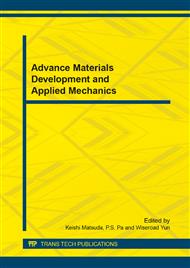[1]
J.H. Tsai, L.W. Lin, A thermal-bubble-actuated micronozzle-diffuser pump, J. Microelectromech. S. 11(2002) 665-71.
DOI: 10.1109/jmems.2002.802909
Google Scholar
[2]
S. Mitsuhiro, I. Tsubasa, U. Shinji, M. Takaaki, S. Kazuo, Fabrication of a bubble-driven arrayed actuator for a tactile display, J. Micromech. Microeng. 18(2008) 065012.
DOI: 10.1088/0960-1317/18/6/065012
Google Scholar
[3]
D. Broek, M. Elwenspoek, Bubble nucleation in an explosive micro-bubble actuator, J. Micromech. Microeng. 18(2008) 064003.
DOI: 10.1088/0960-1317/18/6/064003
Google Scholar
[4]
R. Furberg, B. Palm, S.H. Li, M. Toprak, M. Muhammed, The Use of a Nano- and Microporous Surface Layer to Enhance Boiling in a Plate Heat Exchanger, J. Heat Trans-T. ASME. 131(2009) 101010.
DOI: 10.1115/1.3180702
Google Scholar
[5]
L.W. Lin, Microscale thermal bubble formation: Thermophysical phenomena and applications, Microscale Therm. Eng. 2(1998) 71-85.
DOI: 10.1080/108939598199991
Google Scholar
[6]
L. Lin, K. Udell, A. Pisano, Liquid-vapor phase transition and bubble formation in micro structures, Therm. Sci. Eng. 2(1994) 52-9.
Google Scholar
[7]
X. Peng, H. Hu, B. Wang, Bubble formation of liquid boiling in microchannels, Sci. China Ser E: Technol Sci. 41(1998) 404-10.
DOI: 10.1007/bf02917012
Google Scholar
[8]
X.F. Peng, H.Y. Hu, B.X. Wang, Boiling nucleation during liquid flow in microchannels, Int J Heat Mass Transfer. 41(1998) 101-6.
DOI: 10.1016/s0017-9310(97)00096-3
Google Scholar
[9]
X.F. Peng, D. Liu, D.J. Lee, Y. Yan, B.X. Wang, Cluster dynamics and fictitious boiling in microchannels, Int J Heat Mass Transfer. 43(2000) 4259-65.
DOI: 10.1016/s0017-9310(00)00056-9
Google Scholar
[10]
J.T. Zhang, X.F. Peng, G.P. Peterson, Analysis of phase-change mechanisms in microchannels using cluster nucleation theory, Microscale Thermophys Eng. 4(2000) 177-87.
DOI: 10.1080/10893950050148133
Google Scholar
[11]
X.D. Wang, X.F. Peng, Y. Tian, B.X. Wang, Formation, structure, and evolution of boiling nucleus and interfacial tension between bulk liquid phase and nucleus, Heat Mass Transfer. 41(2005) 651-8.
DOI: 10.1007/s00231-004-0602-9
Google Scholar
[12]
T. Kinjo, K. Ohguchi, K. Yasuoka, M. Matsumoto, Computer simulation of fluid phase change: vapor nucleation and bubble formation dynamics, Comput Mater Sci. 14(1999) 138-41.
DOI: 10.1016/s0927-0256(98)00088-3
Google Scholar
[13]
W.B. Coulter, Means for counting particles suspended in a fluid, (1953).
Google Scholar
[14]
W.H. Coulter, High speed automatic blood cell counter and cell size analyzer, Proc Natl Electron Conf. (1956).
Google Scholar
[15]
O.A. Saleh, L.L. Sohn, Quantitative sensing of nanoscale colloids using a microchip Coulter counter, Rev Sci Instrum. 72(2001) 4449-51.
DOI: 10.1063/1.1419224
Google Scholar
[16]
O.A. Saleh, L.L. Sohn, An Artificial Nanopore for Molecular Sensing, Nano Lett. 3(2002) 37-8.
Google Scholar
[17]
A. Carbonaro, L.L. Sohn, A resistive-pulse sensor chip for multianalyte immunoassays, Lab on a Chip. 5(2005) 1155-60.
DOI: 10.1039/b504827c
Google Scholar
[18]
V.J. Ashish, Z. Jiang, H. Jun, C. Joan, Detection and counting of micro-scale particles and pollen using a multi-aperture Coulter counter, Meas Sci Technol. 17(2006) 1706.
DOI: 10.1088/0957-0233/17/7/008
Google Scholar
[19]
R. Rodriguez-Trujillo, C.A. Mills, J. Samitier, G. Gomila, Low cost micro-Coulter counter with hydrodynamic focusing, Microfluid Nanofluid. 3(2007) 171-6.
DOI: 10.1007/s10404-006-0113-8
Google Scholar
[20]
X.F. Peng, Y. Tien, D.J. Lee, Bubble nucleation in microchannels: statistical mechanics approach, Int J Heat Mass Transfer. 44(2001) 2957-64.
DOI: 10.1016/s0017-9310(00)00323-9
Google Scholar
[21]
J. Yang, S. Waltermire, Y. Chen, A.A. Zinn, T.T. Xu, D. Li, Contact thermal resistance between individual multiwall carbon nanotubes, Appl Phys Lett. 96 (2010 ).
DOI: 10.1063/1.3292203
Google Scholar
[22]
M.M. Nayak, S. Srinivasulu, K. Rajanna, S. Mohan, A.E. Muthunayagam, Electrical and strain-sensitive behaviour of sputtered gold films, J Mater Sci Lett. 12(1993) 119-21.
DOI: 10.1007/bf00241866
Google Scholar


